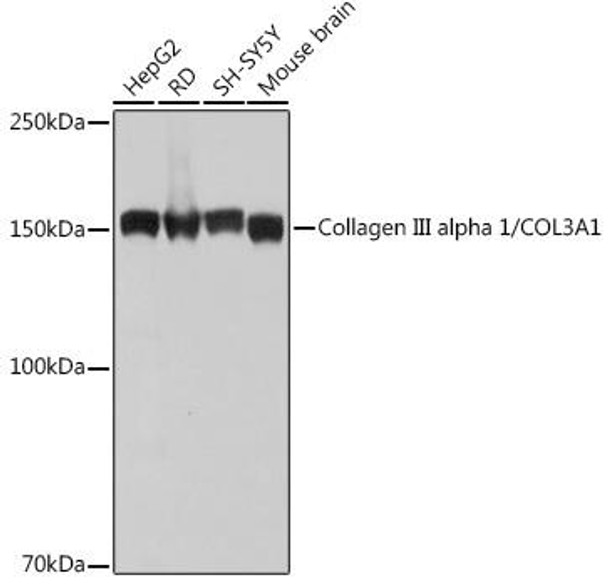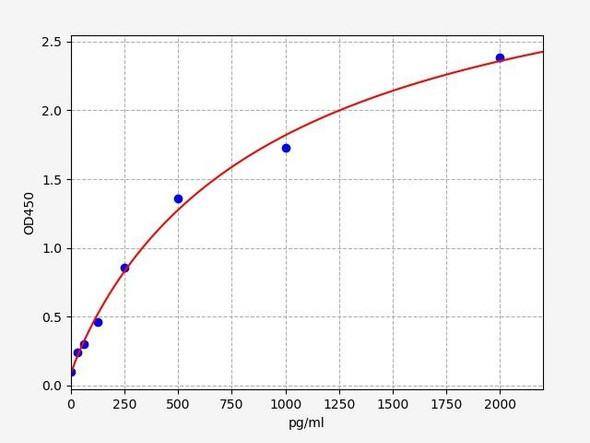Anti-Collagen III alpha 1/COL3A1 Antibody (CAB0817)
- SKU:
- CAB0817
- Product type:
- Antibody
- Antibody Type:
- Monoclonal Antibody
- Reactivity:
- Human
- Mouse
- Rat
- Host Species:
- Rabbit
- Isotype:
- IgG
- Synonyms:
- COL3A1
- EDS4A
- collagen alpha-1(III) chain
Description
| Product Name: | Collagen III alpha 1/COL3A1 Rabbit mAb |
| Product Code: | CAB0817 |
| Size: | 20uL, 50uL, 100uL |
| Synonyms: | COL3A1, EDS4A, collagen alpha-1(III) chain |
| Applications: | WB, IF, IP |
| Reactivity: | Human, Mouse, Rat |
| Host Species: | Rabbit |
| Immunogen: | A synthesized peptide derived from human Collagen III alpha 1/COL3A1. |
| Applications: | WB, IF, IP |
| Recommended Dilutions: | WB 1:500 - 1:2000 IF 1:50 - 1:200 IP 1:50 - 1:200 |
| Reactivity: | Human, Mouse, Rat |
| Positive Samples: | HepG2, RD, SH-SY5Y, Mouse brain, Mouse uterus, Rat lung, Rat uterus |
| Immunogen: | A synthesized peptide derived from human Collagen III alpha 1/COL3A1. |
| Purification Method: | Affinity purification |
| Storage: | Store at -20°C. Avoid freeze / thaw cycles. Buffer: PBS with 0.02% sodium azide, 50% glycerol, pH7.3. |
| Isotype: | IgG |
| Sequence: | Email for sequence |
| Gene ID: | 1281 |
| Uniprot: | P02461 |
| Cellular Location: | Secreted, extracellular matrix, extracellular space |
| Calculated MW: | 111kDa/138kDa |
| Observed MW: | 150KDa |
| UniProt Protein Function: | CO3A1: Collagen type III occurs in most soft connective tissues along with type I collagen. Defects in COL3A1 are a cause of Ehlers-Danlos syndrome type 3 (EDS3); also known as benign hypermobility syndrome. EDS is a connective tissue disorder characterized by hyperextensible skin, atrophic cutaneous scars due to tissue fragility and joint hyperlaxity. EDS3 is a form of Ehlers-Danlos syndrome characterized by marked joint hyperextensibility without skeletal deformity. Defects in COL3A1 are the cause of Ehlers-Danlos syndrome type 4 (EDS4). EDS is a connective tissue disorder characterized by hyperextensible skin, atrophic cutaneous scars due to tissue fragility and joint hyperlaxity. EDS4 is the most severe form of the disease. It is characterized by the joint and dermal manifestations as in other forms of the syndrome, characteristic facial features (acrogeria) in most patients, and by proneness to spontaneous rupture of bowel and large arteries. The vascular complications may affect all anatomical areas. Defects in COL3A1 are a cause of susceptibility to aortic aneurysm abdominal (AAA). AAA is a common multifactorial disorder characterized by permanent dilation of the abdominal aorta, usually due to degenerative changes in the aortic wall. Histologically, AAA is characterized by signs of chronic inflammation, destructive remodeling of the extracellular matrix, and depletion of vascular smooth muscle cells. Belongs to the fibrillar collagen family. 2 isoforms of the human protein are produced by alternative splicing. |
| UniProt Protein Details: | Protein type:Secreted; Motility/polarity/chemotaxis; Extracellular matrix; Secreted, signal peptide; Cell adhesion Chromosomal Location of Human Ortholog: 2q31 Cellular Component: extracellular matrix; extracellular space; endoplasmic reticulum lumen; extracellular region; collagen type III Molecular Function:integrin binding; protein binding; extracellular matrix structural constituent; platelet-derived growth factor binding; metal ion binding; SMAD binding Biological Process: integrin-mediated signaling pathway; skin development; platelet activation; axon guidance; receptor-mediated endocytosis; extracellular matrix organization and biogenesis; collagen fibril organization; wound healing; heart development; cell-matrix adhesion; negative regulation of immune response; positive regulation of Rho protein signal transduction; collagen catabolic process; extracellular matrix disassembly; response to radiation; gut development; response to mechanical stimulus; response to cytokine stimulus; transforming growth factor beta receptor signaling pathway; fibril organization and biogenesis; cerebral cortex development; peptide cross-linking; skeletal development; aging Disease: Ehlers-danlos Syndrome, Type Iv, Autosomal Dominant; Ehlers-danlos Syndrome, Type Iii |
| NCBI Summary: | This gene encodes the pro-alpha1 chains of type III collagen, a fibrillar collagen that is found in extensible connective tissues such as skin, lung, uterus, intestine and the vascular system, frequently in association with type I collagen. Mutations in this gene are associated with Ehlers-Danlos syndrome types IV, and with aortic and arterial aneurysms. Two transcripts, resulting from the use of alternate polyadenylation signals, have been identified for this gene. [provided by R. Dalgleish, Feb 2008] |
| UniProt Code: | P02461 |
| NCBI GenInfo Identifier: | 124056490 |
| NCBI Gene ID: | 1281 |
| NCBI Accession: | P02461.4 |
| UniProt Secondary Accession: | P02461,P78429, Q15112, Q16403, Q53S91, Q541P8, Q6LDB3 Q6LDJ2, Q6LDJ3, Q7KZ56, D2JYH5, D3DPH4, |
| UniProt Related Accession: | P02461 |
| Molecular Weight: | |
| NCBI Full Name: | Collagen alpha-1(III) chain |
| NCBI Synonym Full Names: | collagen, type III, alpha 1 |
| NCBI Official Symbol: | COL3A1 |
| NCBI Official Synonym Symbols: | EDS4A |
| NCBI Protein Information: | collagen alpha-1(III) chain; collagen alpha-1(III) chain; collagen, fetal; alpha1 (III) collagen; Ehlers-Danlos syndrome type IV, autosomal dominant |
| UniProt Protein Name: | Collagen alpha-1(III) chain |
| Protein Family: | Collagen |
| UniProt Gene Name: | COL3A1 |
| UniProt Entry Name: | CO3A1_HUMAN |








